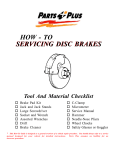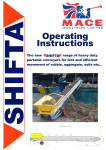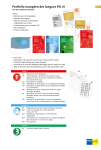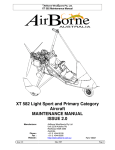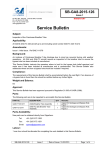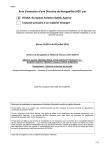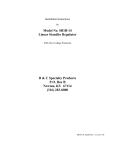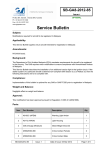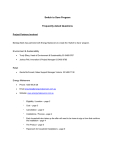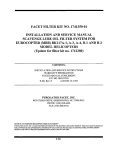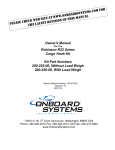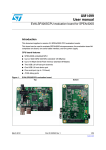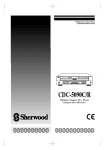Download SL-GA8-2006-04 - Mahindra Aerospace
Transcript
SL-GA8-2006-04 Issue 1 PO Box 881, Morwell, Victoria 3840, Australia Ph + 61 (0) 3 5172 1200 Fax + 61 (0) 3 5172 1201 www.gippsaero.com Service Letter Subject: This service letter is intended to provide a guide for an efficient method of assembling a GA8 received in a shipping container. These instructions are not to be used in isolation, as reference must always be made to the approved aircraft documentation and all work must be carried out and certified in accordance with the requirements of the appropriate National Airworthiness Authority. Gippsland Aeronautics strongly recommends that personnel involved in the assembly and maintenance of the GA8 Airvan complete factory delivered GA8 Maintenance Familiarisation training. Applicability: All GA8 aircraft containerised for transport. Amendments: Nil – initial issue Background: For overseas transport the GA8 is disassembled and crated into a sea container. The principle of the design of the “in container” fuselage support frame (main undercarriage legs removed) requires the container to be at ground level for minimum effort to remove fuselage in terms of man-hours, safety considerations and ease of assembly. The fuselage support frame is attached to the nose leg and main undercarriage pick-up points, its base allows the fuselage assembly to be slid out onto the hangar floor, and is at a comfortable/suitable work height, to prepare wing and empennage mounting points for assembly. Following the fitting of the complete empennage and wings, the standard wing jack points can be used to raise the aircraft to a suitable height to install and secure the main and nose undercarriage. Aircraft is stabilised for and aft via the tail support point provided in the ventral fin. Instructions: 1. Equipment Required 1.1. Packing pieces/sloping ramps will be required to remove the fuselage from the container. NOTE: This is to prevent the tail end of the fuselage contacting the roof if the nose is lowered too quickly. 1.2. Standard set of AF spanners, wrenches and sockets. 1.3. Battery powered drills, screwdrivers for quick removal of industrial hex head screw fasteners used for securing and packing. 1.4. Wing installation trestles and supports: can be supplied by the factory or alternatively can be built from factory supplied sketches. 1.5. Aircraft jacks (Cessna single engine wing type jacks are suitable – compressed height approximately 70 inches, extended height approximately 80 inches above ground). SL-GA8-2006-04 Issue: 1 Date of Issue: 5 June 2006 Page 1 of 13 1.6. Suitable padding/trestles to support the wings and tail surfaces on while cleaning, inspecting and lubricating fittings as required prior to assembly. Support wings under “double ribs,” identified by the double rivet rows/runs. 1.7. Lubricants as per GA8 Service Manual Chapter section 12-20-30. 2. Personnel/Labour Requirements 2.1. Assuming the use of wing support trestle (on wheels and height adjustable), approximately five people to remove fuselage and wings for approximately one hour. Occasionally three men for three hours and two men for approximately fifteen hours each. The typical re-assembly should take approximately fifty to sixty man-hours labour. 3. Removal of Aircraft from Container Description Initial Date Before opening container door check seal installed – may have been replaced by customs, but should be intact. Open doors and Inspect for any damage, corrosion from seawater, etc. If damage is apparent take photos and contact insurance company prior to proceeding. You will require authorisation by Insurance to proceed further should damage be apparent. Remove any items stowed on front of or around fuselage that would impede removal. Items stowed in the rear of container between wings can remain until easy access is gained by removal of fuselage. Remove restraining straps from fuselage support frame and slide/wheel out, being careful not to prematurely lower nose that may result in damage to upper surface of rear fuselage by contacting the container roof. Remove entire fuselage assembly clear of container by at least 25 feet (8 metres) to allow easy removal of wings from container. NOTE: Wing, struts and horizontal stabilizer fittings and attach hardware etc. can be cleaned, inspected and anti-seize lubrication carried out and installed immediately if desired, or can be removed from container and rested on suitable padded trestles etc. to allow rapid container despatch. SL-GA8-2006-04 Issue: 1 Date of Issue: 5 June 2006 Page 2 of 13 4. Horizontal Stabilizer/Elevator Assembly Installation Description Initial Date To remove from container, use two persons to support horizontal stabilizer and elevator assembly. Using battery-powered driver remove fasteners. Remove complete assembly from container, carry out inspection for shipping damage, place on suitable trestles/tables, clean attachment fittings, bolts etc, lubricate with general purpose grease and ensure trim jack shaft is clean and lubricated IAW GA8 Service Manual Chapter 12-2030. Also clean and lubricate rear stabiliser attachment fittings and pivot bushes. NOTE: Ensure that the stabiliser trim jack shaft has remained secured by cable-ties to the bulkhead just forward. If the shaft is not secured and the forward trim wheel has been moved, there is a possibility that the trim system rigging may have become incorrect and will require checking IAW GA8 Service Manual Chapter 27-30-10. With the aid of a person on either tip, lift assembly into position above rear fuselage pivot attach fittings. NOTE: Ensure pivot bushes are installed. Utilizing a third person, install NAS6605-20 bolts (heads outboard) AN960– 516 washers, MS21042-5 nuts and correctly torqued IAW GA8 Service Manual Chapter 20-10-00 and install theAN356-524 pal nuts. Check that the leading edge of stabilizer moves up and down without binding. It is required that the outer flanges of the tailplane fitting clamp tightly on inner pivot bush to ensure the bushing rotates in the rear fuselage lug. Slide the upper end of the trim jack between front spar attach fittings ensuring that the anti rotation spacers are fitted. Install the AN5-14A bolt with AN960-516 washer under the head, MS21042-5 nut and washer, and torque IAW GA8 Service Manual Chapter 20-10-00. Install AN356-524 Pal nut and ensure uniball bearing is clamped tightly. Attach trim indicator operating cable on the forward face of the front spar. Check stabilizer and indicator rigging IAW GA8 Service Manual Chapter 2730-10 and Type Certificate Data Sheet. Connect both elevator push rods to the elevator operating horns torque bolts IAW GA8 Service Manual Chapter 20-10-00. SL-GA8-2006-04 Issue: 1 Date of Issue: 5 June 2006 Page 3 of 13 5. Vertical Fin Installation Description Initial Date Initial Date Clean and inspect forward and rear spar attach holes, faces and bolts. Apply a light coating of preferred corrosion protection (i.e. LPS3 or similar). Three persons and a 10 ft (3 metre) high stepladder or work platform are preferable for fin initial installation. Pass the fin assembly to person on ladder/work platform and lower the assembly down into position ensuring correct fore/aft alignment. Loosely install 2 bolts in front and rear fin spars to safely hold fin in position. One person can finish the installation and torquing of the bolts in the rear spar, two persons required to correctly torque forward spar bolts. NOTE: Ensure unthreaded portion of all bolts protrudes through spars and bulkheads and sufficient washes are used under the nut to prevent nut binding. Correctly torque all nuts IAW GA8 Service Manual Chapter 20-10-00. Connect the strobe light/beacon and radio coax cables at the base of the fin. 6. Rudder Installation Description Clean and inspect rudder, hinge pivots and mass balance attachments. Lubricate pivot bushes and hinge holes with grease. Rudder can be installed with lower mass balance weight fitted – upper balance weight must be removed. NOTE: GA8 IPC Chapter 27 Figure 27-37 shows correct installation of rudder pivot bushes and attach hardware. Install upper and middle hinge bushes and bolts. Take particular notice of Note 1 of IPC Figure 27-37 regarding “spacer” washers and lower hinge bolt length. Spacer washers should be added until just taking up the gap. Install lower washes and MS21042 nuts, tighten and ensure pivot bushes are clamped and rotate with rudder. SL-GA8-2006-04 Issue: 1 Date of Issue: 5 June 2006 Page 4 of 13 Description Initial Date Connect rudder cables. NOTE: It is usual that rudder cables are disconnected without disturbing the original rigging and the lock wire should be found intact. They can easily be reconnected by attaching one cable, then with the nose wheel held in position, moderate pressure on the trailing edge at lower rib position of rudder will allow easy installation of the second rudder clevis bolt. Install both castellated nuts and split pin. Place the upper mass balance weight in position and install the 2 x AN4 bolts and washers leaving the bolts loose enough so that the weight can be rotated to align the pop rivet holes at each end of the weight. When the holes are aligned the bolts can be tightened and the pop rivets installed. NOTE: If the pop rivet holes do not align then the weight may need to be swapped end for end. Check complete rudder system installation IAW GA8 Service Manual Chapter 27 Section 27-20-00. 7. Wing Installation NOTE: Whether the aircraft is on the shipping fuselage support frame or is on its wheels, it is stable with only one wing attached (assuming no fuel). Description Initial Date Clean, inspect and grease all wing, strut, fuselage pick up points and bolts etc. Remove all blanking, packaging tape from fuel supply and vent lines. Check and ensure they are all clear. Lightly grease outer surface of pipes and inner surface of rubber sleeves to allow easy assembly. Lift wing assembly onto mobile wing rigging trestle (or manhandle with 4-5 people) and adjust to correct height. Move wing assembly carefully towards correct position while feeding the aileron control cables into their correct positions, also ensue smooth insertion of fuel supply and vent lines. NOTE: On left hand side fuselage rear spar ensure cam adjusters (if fitted) are well greased and inserted and the bolt holes aligned with each other. It has generally been found that balanced flight in terms of roll is achieved with the rear spar near the lowered position. When front and rear spar holes are aligned in fittings, install bolts. See GA8 IPC Chapter 57 Figure 57-1. SL-GA8-2006-04 Issue: 1 Date of Issue: 5 June 2006 Page 5 of 13 Strut Installation – Lower End (See GA8 IPC Figure 57-2) Description Initial Date Initial Date Initial Date Identify lower end of strut and carefully insert into position. NOTE: Ensure fork mating surfaces are well greased to prevent galling during insertion. Line up lower boltholes and partially insert bolt. Partial insertion allows slight twisting or radial movement of strut thus aiding installation alignment at the upper end. Strut Installation – Upper end (See GA8 IPC Figure 57-2) Description Again make sure the wing mounted strut attach lug faces are well greased to prevent galling. Raise upper end of strut and insert into position. If wing lugs appears too far apart a G clamp can be successfully used to slightly squeeze or spring them together to allow entry into the strut fork. Raise or lower wing to align boltholes, locate tie down bracket into position and install bolt. Install all double locking nuts. NOTE: It is easier to feed the 2 nuts into the lower strut attach bolt progressively as the bolt is moved in, due to limited access. Modified open-end spanners or wrenches can be used. Carefully tighten all primary nuts and then lock secondary nuts onto the primary nut. NOTE: The primary and secondary nuts are an FAA requirement, however they are awkward and require considerable care to install correctly as intended, especially the smaller diameter nuts as on the rear spar bolts, they are narrower than most spanners and wrenches and the threads in these nuts can strip very easily if over torqued due to the limited number of threads in each nut. Fuel and Vent Lines Description Ensure rubber hose joining sleeves are centred over the gap between the ends of the pipes, also that sufficient engagement has been achieved to allow correct clamping and sealing by the hose clamps. Tighten all hose clamps. NOTE: Care should be taken when starting threads on all fuel line fittings at the wing roots as they can be easily cross threaded and damaged. Care should also be also be exercised to ensure that all fitted are well supported when tightened. SL-GA8-2006-04 Issue: 1 Date of Issue: 5 June 2006 Page 6 of 13 Control Cables Systems - Ailerons Description Initial Date Initial Date Initial Date Initial Date Initial Date Ensure correct routing of aileron left and right driving and balance cables. Ensure sufficient, even and correct thread engagement in turn barrels. Carry out Rigging and Cable tension IAW GA8 Service Manual Section 2710-00. Control Cables Systems – Flaps (See GA8 IPC Figure 27-7) Description Connect cables to Flap Torque tube operating arms. Ensure sufficient even and correct thread engagement in turnbuckles. Carry out rigging and cable tension IAW GA8 Service Manual Section 2750-00. Electrical Connectors Description Identify and correctly connect plugs located left and right leading edge section of wing roots. Pitot/Static Lines Description Locate and connect in Left hand wing root. Pitot Static Head Assembly Description Remove left hand fibreglass tip faring (GA8 IPC Figure 57-1 Item 3, Part No. GA8-571019-11). Pitot-static assembly is stored inside with the pitot and static lines connected. The mount bolts and stand off spacers can be found in their appropriate holes in the end rib. Attach the pitot head using the hardware as removed (connect the plug for the heated pitot and test if fitted). Check pitot-static lines are correctly installed and tightened. Carry out a pitot-static leak check IAW GA8 Service Manual Section 34-1000. Install the tip fairing. SL-GA8-2006-04 Issue: 1 Date of Issue: 5 June 2006 Page 7 of 13 8. Undercarriage Installation Description Initial Date Initial Date Initial Date Install wing jacks and tail support IAW GA8 Service Manual Section 7. Pay attention to Caution regarding empty weight longitudinal centre of gravity. Raise aircraft sufficiently to remove weight from main undercarriage and nose leg attach bolts from shipping fuselage support frame. Raise aircraft clear of frame, remove inboard securing bolts from main undercarriage support bars and remove from fuselage. Clean and inspect main undercarriage legs, fuselage mounting fittings, nose leg fork and mounting pad. Lightly grease faces or apply preferred anti-corrosion treatment (LPS 3 or similar). Main Undercarriage Description Insert main legs into fuselage fittings and install outboard NAS mounting bolts first (this gives easier access, spanner/wrenches are not continually hitting inboard bolt heads). See GA8 IPC Figure 32-1 Items 33 and 34, GA8 Service Manual Chapter 32-10-00. Tighten 16 mounting bolts, double check recommended) and install bolt retaining cap. (independent check Install brake caliper onto torque plate and secure pad assembly. Secure brake line to leg and install the leg fairings. Nose Wheel (See GA8 IPC Figure 32-4 View DD) Description NOTE: Nose wheel fork is not handed therefore has no front or rear. Locate fork and wheel assembly, as shown in View DD. Install 4 mounting bolts, washers and nuts and correctly torque. Correctly inflate tyres. Mains - 29 psi Nose – 33 psi Lower aircraft off jacks. SL-GA8-2006-04 Issue: 1 Date of Issue: 5 June 2006 Page 8 of 13 9. Electrical System Battery Description Initial Date Initial Date Initial Date Initial Date It would be preferable to ensure aircraft battery is fully charged. This can be accomplished by either removing the battery and charging on 14 volt charger as required by battery manufacturers recommendations (supplied in Aircraft Documents), or using 3 pin ground power plug, connect 14 volt Ground power until current drain is nearly zero or with aircraft master switches on, battery voltage is 14 volts. NOTE: When battery is only partially charged Voltage indication is proportionally lower i.e. 10 to 14 volts. Electrical System Checks Description With ground power installed or battery fully charged, turn on Master Switches. Ensure all breakers are in and check operation of all electrical systems in particular the following items disturbed by disassembly. Nav Lights Strobe Lights Pitot Heat – ensure pitot heat cover is removed, short test to prevent overheating, beware of burns. 10. Final Checks Fuel System Leak Check Description Ensure fuel drains are tight (are left loose following de-fuelling prior to disassembly) and closed. Add approximately ¼ fuel to each tank and check for leaks. NOTE: A slow leak may take some time to become visible, preferably leave overnight. Brake System Description Cycle brake pedals until pedal becomes firm (this action moves the pistons out in the wheel calipers until they are in the normal position). Remove fill cap from Master Cylinder, and using a torch/flashlight ensure reservoir is at least ¾ full – MIL-H-5606 hydraulic fluid. SL-GA8-2006-04 Issue: 1 Date of Issue: 5 June 2006 Page 9 of 13 Flight Controls/Wings/Empennage Description Carry out independent inspections of the following installations and systems: a) Installation attach fasteners and locking of wings and empennage b) Primary flight control systems c) All control surface attach points are correctly installed and locked. First inspection Signature Authority Number Date Second inspection Signature Authority Number Date Description Initial Date Initial Date Install all interior trim panels, seats and carpets. Install all fairings. Engine Description De-inhibit engine as per Lycoming service letter SL-L180B. Carry out inspection forward of firewall to ensure: a) All engine controls are correctly installed, operation correct. b) Silica – Moisture absorbent bags etc. removed. c) Oil System – correct level and oil type. d) Remove covers from exhaust tail pipes. e) Engine may need cleaning externally to remove excess corrosion inhibitor applied prior to shipping. Install all engine cowls. SL-GA8-2006-04 Issue: 1 Date of Issue: 5 June 2006 Page 10 of 13 Engine Ground Run Carry out the following engine ground run: Record OAT _____°C Record Altitude _______ ft Item Static MP _______in.Hg Description Result 1 Auxiliary fuel pump operation (record pressure mixture ICO) 2 Normal cranking and starting Yes / No 3 Oil pressure rising (light off) Yes / No 4 Alternator light off Yes / No 5 Ammeter charging Yes / No 6 Vacuum light off and gauge indicating Yes / No 7 CHT rising Yes / No 8 Engine warm Yes / No 9 Shut down and check for leaks OK / Not OK 10 Re-install cowls and repeat engine start and warm-up Items 1 through 8 OK / Not OK 11 Magneto check at 1800 RPM psi Mag drop LH Mag Selected RPM RPM Mag drop RH Mag Selected 12 Pitch operation normal (cycle prop at 1500 RPM) 13 Record at Full Throttle RPM RPM Full throttle check not to exceed 30 seconds Manifold Pressure in.Hg Vacuum in.Hg Ensure tarmac is clear of debris Yes / No Oil Pressure psi Oil Temperature °C Fuel Pressure psi Fuel Flow L/Hr CHT EGT Recording SL-GA8-2006-04 Issue: 1 Date of Issue: 5 June 2006 °C Yes / No Page 11 of 13 14 Record at Idle Idle Normal Yes / No RPM RPM Oil Pressure psi Oil Temperature °C Magneto Dead Cut Yes / No Idle Mixture Check Lean / OK / Rich Normal Shut Down Yes / No 15 Abnormal vibrations at any RPM Yes / No 16 Engine security and leak check OK / Not OK 17 Ensure all panels installed 18 Engine run carried out (Refer Lycoming Section 3) Operator’s Yes / No Print Name Manual Signed Date 19 Remarks: Description Initial Date Check correct operation of avionics. When moving off to taxi check brakes – correct operation. Prepare aircraft for flight. Complete log book entries and certify. Check and ensure all AD’s, SB etc have been carried out, complied with as required by the country’s National Airworthiness Authority. SL-GA8-2006-04 Issue: 1 Date of Issue: 5 June 2006 Page 12 of 13 11. Flight Check and Delivery Description Initial Date During check flight: observe all systems for normal operation. In smooth air at approximately 23” in.Hg MP, 2300 RPM check lateral rigging (i.e. does aircraft tend to roll left or right). NOTE: Skid ball should be checked prior to flight, must be centred when cabin floor laterally level. Adjust rear spar cam adjuster IAW Service Letter SL-GA8-2004-02 to ensure hands off, wings level. NOTE: If aircraft is tending to yaw, ball must be kept centred with rudder application. NOTE: For aircraft not fitted with a rudder trim tab, refer to Service Bulletin SB-GA8-2005-22 for rudder tab installation and adjustment. Ensure the exterior of aircraft is clean. Ensure interior is clean. Fingermarks removed, carpet vacuumed. Ensure seats installed correctly. Ensure all shoulder harnesses installed correctly. All customer ordered items present and correct. SL-GA8-2006-04 Issue: 1 Date of Issue: 5 June 2006 Page 13 of 13













